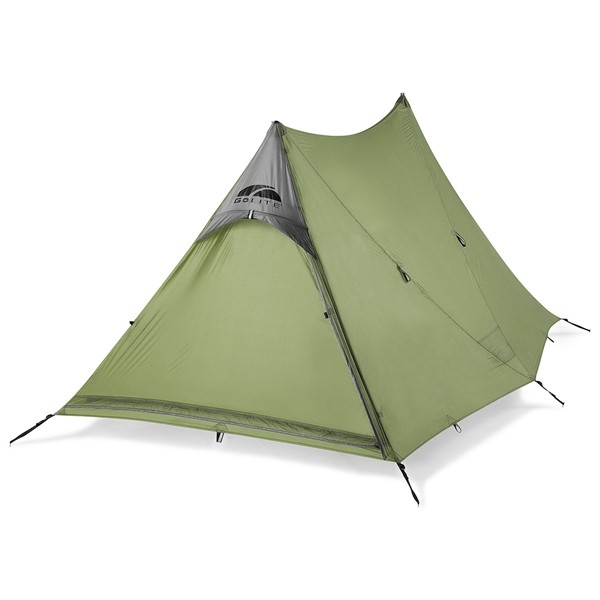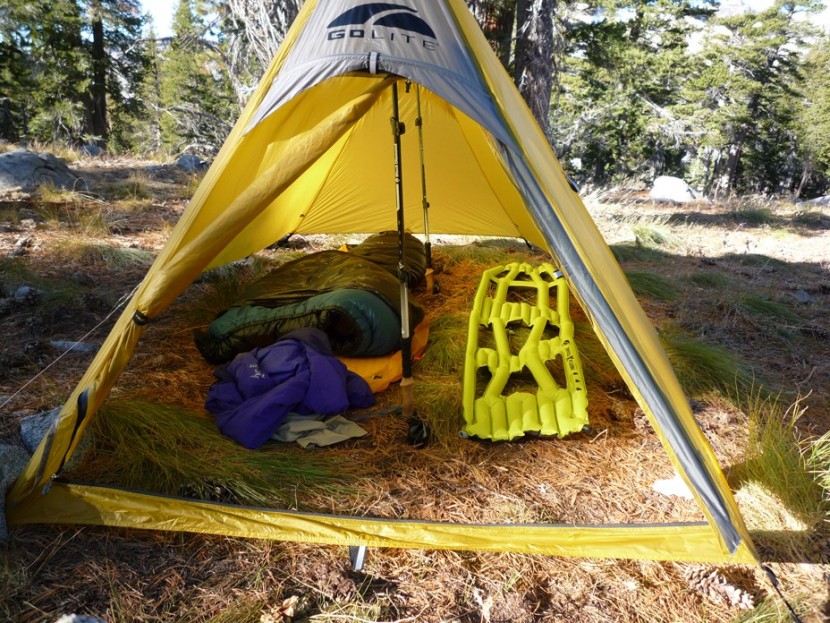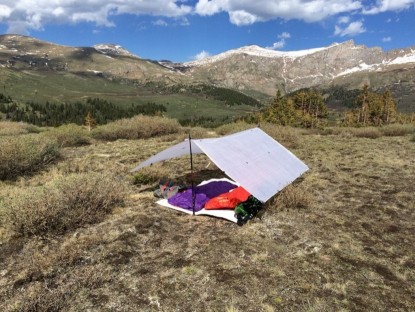GoLite Shangri-La 2 Tarp Review
Our Verdict
Our Analysis and Test Results
Livability
Even when pitched tight against the ground the Shangri-La is tall enough for two six-foot-tall people to sit up in and more than long enough for people of the same height to lay down and have a significant amount of covered space for gear. This shelter has more than twice the space of lighter double wall tents found in our best backpacking tent review. It also has more space than smaller mids like the Mountain Laurel Designs DuoMid. It's comfortable regardless of the conditions and is large enough to be used for other purposes such as a small group cook tent for longer gear laden mountaineering trips. This shelter is the only mid we've tested that has pockets (two in the center of each side wall) which you may or may not find useful. Reflective guy points make it easier to spot the shelter at night. Vents on either end help to combat condensation.
Weather Resistance
Like all mids, the Shangri-La has four walls that stop wind and precipitation of all types from all sides. It comes with webbing loops on the six main perimeter guy points and has numerous other mid-level points that allow you to pull it taut for serious storms. The Shangri-La offers far more protection than A-frame tarps, which can be useful in very exposed areas and for use in light winter conditions. However, various design attributes and moderate quality fabrics do not allow the Shangri-La to function in severe winter use. It's best for 3-season backpacking and can handle light snow (~6"). In winter, there is a massive difference in the performance of the Shangri-La and pyramids like the Mountain Laurel Designs SuperMid and DuoMid, and the Hyperlite Mountain Gear UltaMid.
Ease of Pitching
The long and narrow Shangri-La pitches fast both by first-time users and by experienced veterans. Unfortunately, you'll need to add line to the ground level loops. We prefer pyramids that have linelocs fixed to the ends because they are easier to pitch and can be adjusted from inside the tent when it's raining (tighten to combat stretch from nylon absorbing water).
Weight and Packed Size
The Shangri-La 2 weighs 22 ounces without additional guylines or stakes. This weight is moderately light, but since the shelter doesn't perform as well as others in winter, our testers reach for slightly heavier models (like the SuperMid).
Adaptability
Mids are the least adaptable type of shelter, and the Shangri-La is no exception. It must be pitched in the same way every time. That is, it doesn't respond well to campsites that require a suboptimal pitch; you must hike on and find somewhere to pitch it. For many people, this will not be a serious drawback. Long distance thru-hikers may prefer a more adaptable type of shelter, such as an A-frame or flat tarp, that provides more flexibility with campsite selection.
Limitations
The Shangri-La 2's greatest limitation is its B quality fabric. GoLite uses a 15 Denier ripstop nylon that's coated with silicone on one side and polyurethane on the other. Our experience testing dozens of tents and shelters shows that silnylon (coated on both sides with silicone) is more durable and stronger than those that use polyurethane coated fabrics. The Shangri-La 2 would benefit from a better material; we believe it would hold up to serious storms better — it would be less likely to tear — and provide increased performance for the worst conditions and multi-week or multi-month trips. The Shangri-La is constructed well but doesn't have the completely bombproof attention to detail found on the silnylon shelters from Mountain Laurel Designs. For most backpackers, this should not be a serious drawback.
To be adequately pitched for a severe storm, we believe the shelter needs at least 50 feet of cord attached to its various tieouts. We recommend adding more line to the perimeter loops or replacing them with higher quality and lighter line that doesn't absorb as much water. It's hard to achieve a “perfect pitch” (when everything is perfectly tight with the same amount of stress on each area) with the Shangri-La. The combination of the shelter's large side walls that catch the wind, B+ quality fabric, and B+ quality construction lead us to prefer other shelters for unprotected use in winds around or over 30mph. Here's a video of an older version Shangri-La 2 in 24-37mph winds.
The webbing loops at the bottom of the six ground-level perimeter points can make it hard to pitch the Shangri-La in uneven terrain. We've found that mids with linelocs on perimeter points are much easier to properly pitch because you can cinch the cord tight after staking. Linelocs also make it easier to deal with the unavoidably sagging of nylon in wet weather; instead of getting out of the tent, just reach to adjust the lineloc. We believe the Shangri-La should come standard with linelocs on all ground level tieouts. Again, this is a relatively minor drawback when you consider the Shangri-La on the whole. You can easily add extra cord the points or sew on linelocs yourself.
A final minor detail: adding more fabric below the door's zipper would allow you to bury the door better in snow. The MSR Twin Sisters has much more material here and creates a snowproof seal easier than the Shangri-La. But, again, for most people who use the shelter more in three-season conditions than in winter, the Shangri-La's design provides an excellent balance of protection in all conditions.
Best Application
Budget ultralight travel in exposed areas and light-duty winter use.






